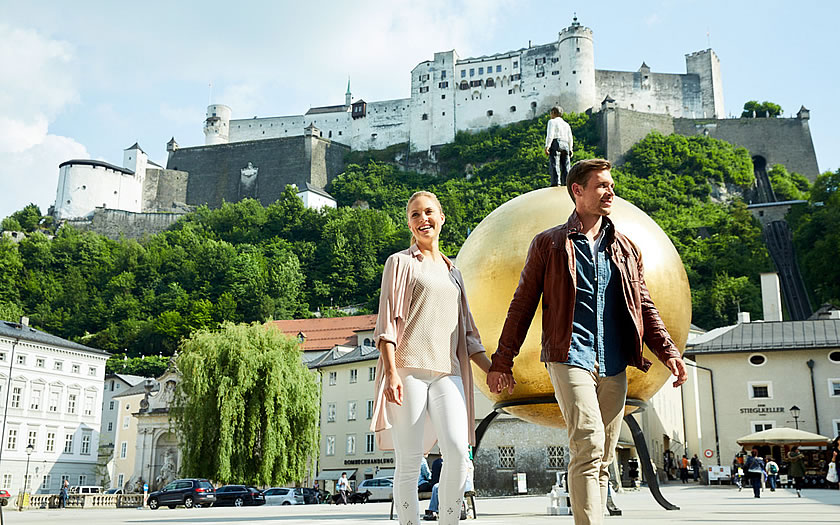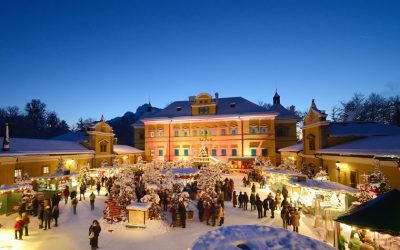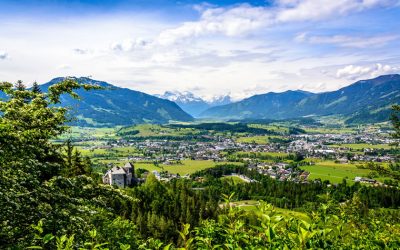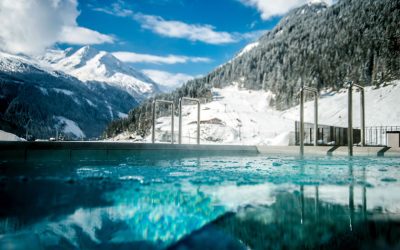Last updated on May 14th, 2021 at 08:09 pm
Over 7.6 million people from all over the world spend their holidays in the SalzburgerLand every year, and around 1.7 million of those guests visit the city of Salzburg during that time.
Thanks to the international art and cultural offerings, the exciting history and the world-famous personalities, the city and province of Salzburg are a real place of pilgrimage for those who love the arts and music.
The Mozart and festival city of Salzburg is considered one of the most prestigious and important music and cultural metropolises in Europe.
#1: UNESCO World Heritage Site on the northern edge of the Alps
Salzburg’s silhouette is unmistakable: the mighty Hohensalzburg fortress with its bright façade towers high above the baroque towers of the city. Behind it rise the rugged peaks of the Alps.
The densely wooded city mountains with their bare cliffs, the narrow terraced houses and the facades in traditional Inn-Salzach architectural style lend the city its charm.
The green banks of the Salzach River, the splashing fountains, cool churches and mystical cemeteries are just as charming.
In Salzburg’s old town, buildings from the Romanesque, Middle Ages, Renaissance, Baroque and Classicist periods can be found in the narrowest of spaces.
UNESCO awarded Salzburg’s Old Town the “World Cultural Heritage” seal of approval back in 1997. The Old Town, the important role of music and the city architecture, shaped by the prince archbishops, are unique in the world. As a UNESCO World Heritage Site, the historic centre of Salzburg and around 1,000 objects such as buildings and monuments are under special protection.
Noone has shaped Salzburg’s baroque cityscape as much as Prince Archbishop Wolf Dietrich zu Raitenau (1559-1617): his vision was to transform Salzburg into a magnificent “Rome of the North”. Even today, the five squares in the Old Town – Residenzplatz, Domplatz, Mozartplatz, Kapitelplatz and Alter Markt – are considered to be the most beautiful places in Salzburg.
The magnificent Residenz fountain was built by Tommaso di Garona between 1659 and 1661 and is the largest baroque fountain in Central Europe. During the Advent period it forms the centre of the famous Salzburg Christmas Market.
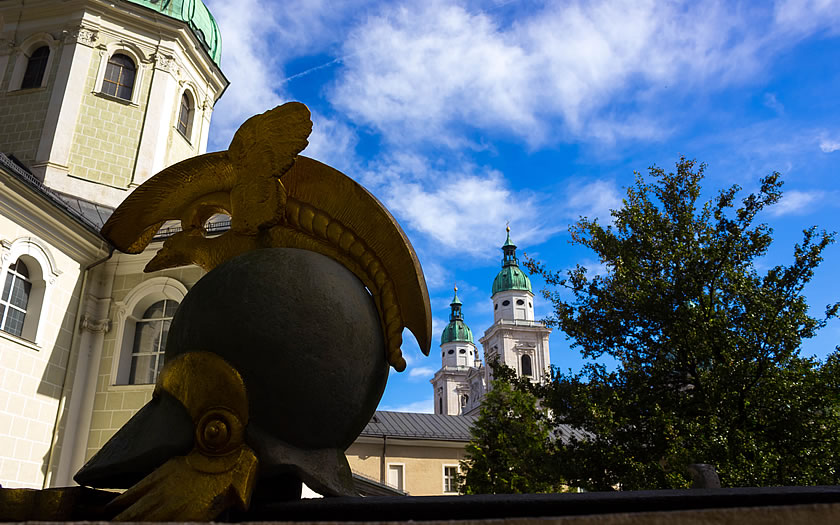
Interesting facts about the UNESCO World Heritage Site at a glance:
- Salzburg is home to the oldest existing monastery in the German-speaking world: St. Peter is considered the “cradle of Salzburg”. The monastery was founded in 696 by Saint Rupert – who is now the patron saint of the province and is commemorated every year on 24 September.
- The fortress Hohensalzburg is the landmark of Salzburg. With almost 1.2 million visitors annually, the fortress is also the most visited sight in the city. It is one of the largest fortresses in Europe dating from the 11th century and is home to a wealth of art historical details, such as some of the most beautiful Gothic secular rooms in Europe.
- Salzburg is home to the Salzburger Almkanal, the oldest water pipe tunnel in Central Europe. It is an artificially created stream bed that brings water from the Königsseeache in Berchtesgaden right into the middle of the city of Salzburg. The heart of the building is the listed “Stiftsarmstollen”, built in 1150, which runs underground through the Mönchsberg. You can see it at the monastery bakery at the entrance to the St. Peter cemetery. Every year in September, the water is drained for cleaning purposes and guided gallery walks are offered.
#2: Wolfgang Amadeus Mozart turned Salzburg into the ‘city of Mozart’
Wolfgang Amadeus Mozart, who opened a new chapter in music history with his talent and work, was born on 27 January 1756 in Salzburg.
The house where he was born in Getreidegasse and the family’s former residence on Makartplatz are among the top three sights of the city of Salzburg: more than half a million people visit the two museums every year. Among the exhibits are a lock of his hair and Mozart’s child violin.
Mozart’s father Leopold was deputy musical director at the Salzburg court, but his son was only moderately happy here: as a freethinker he found it difficult to subordinate himself to the hierarchies and structures.
In 1781 he resigned his post and moved to Vienna, where he died in 1791. W. A. Mozart composed 350 of his most beautiful works in Salzburg, including violin concertos and church sonatas.
The International Mozarteum Foundation was founded in 1880. With its museums, scientific research and events, such as the Mozart Week in January, it is fully committed to preserving Mozart’s legacy. The autograph collection includes hundreds of original letters and manuscripts by Mozart and his father.
Wolfgang Amadeus Mozart is present all over Salzburg: Salzburg Airport bears his name, there is a Mozart Square, a Café Mozart and of course the famous Mozartkugel chocolate. Around 1,500 young artists from all over the world study at the Mozarteum University and the Salzburg Festival has made it a tradition to stage a Mozart opera every year: These include “The Magic Flute”, “Don Giovanni”, “The Wedding of Figaro” and “The Abduction from the Seraglio”.
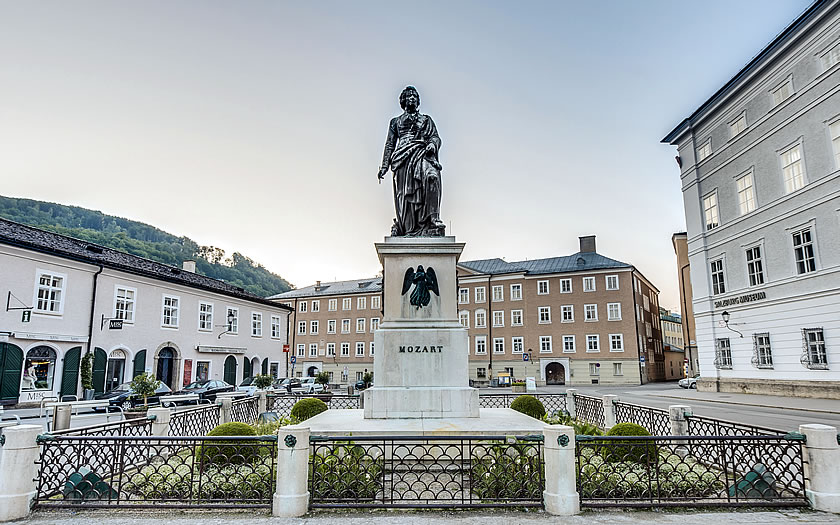
Interesting facts about Salzburg’s most famous son Wolfgang Amadeus Mozart:
- Wolfgang Amadeus Mozart gave his first court concert to Prince Archbishop Sigismund von Schrattenbach at the age of six. This took place in the conference room (“Ratszimmer”) of the prince archbishop’s residence, where 13 years later his Violin Concerto in A major premiered. The state rooms of the Residenz are part of the “DomQuartier Salzburg”.
- The “Original Salzburger Mozartkugel” was created by the Café-Konditorei Fürst in the city of Salzburg. Paul Fürst won the gold medal for his Mozartkugel at the world exhibition in Paris in 1905 and even today the praline is made by hand from exquisite ingredients in an elaborate process.
- W. A. Mozart’s mother Anna Maria came from St. Gilgen am Wolfgangsee and his sister Nannerl also lived there for 17 years. In St. Gilgen, the Mozart fountain on Mozartplatz reminds us of the composer. The “Nannerl Museum” is housed in the Mozart House; the multimedia show “The Mozarts and St. Gilgen” is also shown.
#3: The legendary “Sound of Music”
The film “The Sound of Music” about the Salzburg Trapp family is actually little-known in German-speaking countries. In the USA, Great Britain, China, Japan, Australia, India, the Middle East and Southeast Asia, however, it has become a legend.
More than a billion people have seen the world’s most successful musical film since it was first broadcast in 1965. The film with Julie Andrews as Maria von Trapp and Christopher Plummer as Georg Baron von Trapp was awarded five Oscars and the story based on true events became a legend.
For forty percent of all Salzburg guests, visiting the original locations of the film “The Sound of Music” is the most important reason for their travel: over 300,000 holidaymakers come every year to follow in the footsteps of the Trapp family.
The original “The Sound of Music” tour by bus includes a visit to the Mirabell Garden and Schloss Leopoldskron in the city of Salzburg, Schloss Hellbrunn on the southern edge of the city, St. Gilgen am Wolfgangsee and the collegiate church in Mondsee.
But who were the Trapp family and how did their history become a myth?
The short version goes like this: the widowed submarine captain Georg Freiherr von Trapp, who lives in Salzburg, was looking for a home tutor for his seven children in the mid-1920s.
The novice Maria Augusta Kutschera was placed in the household by the abbess of the Nonnberg monastery. The baron and the young woman fell in love and married and in 1929 and 1931 the daughters Rosemarie and Eleonore were born.
In 1933 the family lost their fortune through speculation and the very musical Maria Augusta founded a family choir with her husband’s children.
Maria von Trapp gave notice to the servants, moved into their rooms with the family and rented out the magnificent part of the house to paying guests.
One of these was Lotte Lehmann, who heard the children sing and encouraged them to take part in a folk music competition. The Trapps won the competition and a radio concert followed.
After Salzburg’s Anschluss, Georg von Trapp was called up to the German Navy but the family fled the Nazis and emigrated to the USA. They settled in Vermont. and in 1939 son Johannes is born.
The family also made concert tours in the USA and mostly performed under the name “Trapp Family Singers”. At the age of 82, Maria Augusta Trapp died in Morrisville on 28 March 1987.
In 1952 she had written her memoirs under the title “From Monastery to World Success”. In 1959 the story was brought to the stage as a musical and was a huge success in the entire English-speaking world. The film adaptation of the musical in 1965 was a triumph for 20th Century Fox Studios.
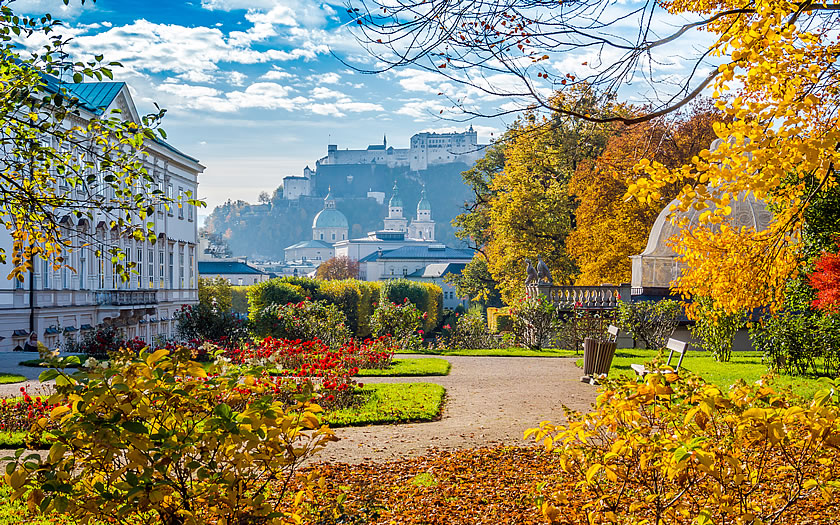
Interesting facts about the Trapp family and “The Sound of Music”:
- In Werfen there is a 1.4 kilometre long “Sound of Music” trail. This trail is lined with 12 stations with interactive elements and leads in about one hour to the famous “Sound of Music” picnic plateau Gschwandtanger. In one of the most famous film scenes Julie Andrews teaches the children the song “Do-Re-Mi”. In the distance you can see Hohenwerfen Castle.
- The musical “The Sound of Music” can be seen at the Salzburger Landestheater. The production, which started in 2011, has received several awards, appeared on CD, toured in Germany and is almost always sold out.
- The legend of “The Sound of Music” can be followed in many ways in the city of Salzburg. For example, at performances in the Salzburg Marionette Theatre, on theme tours by foot or bike through the city, at “Sound of Salzburg Dinner Shows” in the Sternbräu Restaurant or by living in style in the real Villa Trapp.
#4: The world-famous Salzburg Festival
The Salzburg Festival is one of the largest and most renowned music festivals in the world.
On the 42 days from the end of July to the end of August there are over 220,000 tickets for more than 200 performances. Among the most important venues are the Great Festspielhaus, the Felsenreitschule and the Haus für Mozart in the festival district.
The Salzburg Festival was founded in 1920 by the theatre director Max Reinhardt. Together with other local artists and intellectuals, he realised his dream of transforming the whole city into a stage.
Hugo von Hofmannsthal’s “Jedermann” was the first piece of the Salzburg Festival and has remained an indispensable component to this day: the “Jedermann” on Salzburg Cathedral Square has been played by celebrities such as Will Quadflieg, Curd Jürgens, Maximilian Schell, Helmuth Lohner, Klaus Maria Brandauer, Peter Simonischek and currently Tobias Moretti. Christiane Hörbiger, Senta Berger, Sunnyi Melles, Veronica Ferres, Marie Bäumer and Birgit Minichmayr were some of the most impressive artists.
In general, the Salzburg Festival is a hotspot for both world stars and those who have the potential to become one: star violinist Anne-Sophie Mutter and soprano Anna Netrebko were discovered here, Markus Hinterhäuser is current festival director and opera star Cecilia Bartoli is director of the Whitsun Festival.
The world-famous conductor Herbert von Karajan, born in Salzburg on 5 April 1908, founded the Salzburg Easter Festival in 1967 and the Pentecost Festival in 1973, whose quality is also appreciated annually by art and culture lovers from all over the world.
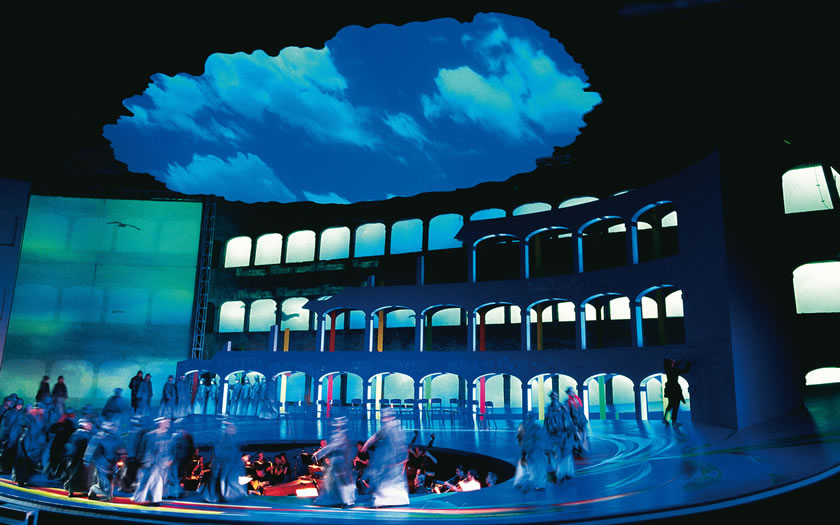
© Tourismus Salzburg GmbH
Interesting facts about the Salzburg Festival:
- Part of the former Hallein saltworks on Pernerinsel is one of the 18 venues of the Salzburg Festival. The hall is mostly used for experimental theatre and concerts of contemporary music.
- The Felsenreitschule in the city of Salzburg was once a conglomerate quarry for the construction of the Salzburg Cathedral. From 1926 the former summer riding school of the prince archbishop was used for outdoor performances of the Salzburg Festival: at the end of the 1960s it was redesigned and enlarged.
- The frescoes in the entrance area of the Haus für Mozart were painted by the Salzburg painter Anton Faistauer from Maishofen. Faistauer painted the frescoes in 1926/27, laying the foundation for his international breakthrough. The masks on the façade were painted by Prof. Jakob Adlhart, whose other works include the Grace Chair in St. Andrä’s Church in Salzburg and the Zeiserl fountain in Hallein.
- The Salzburg Festival celebrates its 100th birthday in 2020. In addition to spectacular opera productions and concerts with world-famous orchestras and artists, the history of this important cultural and classical festival will be documented in the Salzburg Museum with a large-scale regional exhibition.
#5: Cradle of the Christmas carol ‘Silent Night’
The most famous and popular Christmas carol in the world “Silent Night” is sung annually by around two billion people in over 300 languages and dialects.
The text was written in 1816 by Joseph Mohr in Mariapfarr in Salzburg’s Lungau district, and the melody was composed in 1818 in Arnsdorf by Franz Xaver Gruber.
The song was sung for the first time on 24 December 1818 in Oberndorf near Salzburg: by its creators – the Salzburg auxiliary priest Joseph Mohr and the young teacher Franz Xaver Gruber.
In the two hundred years of its existence, the song has embarked on a wondrous journey all over the world: it is known on all continents and is loved and appreciated – regardless of languages and denominations.
It is regarded as a carol for world peace whose message of hope and love has touched people both then and now. Among the seven silent night places in the SalzburgerLand are the city of Salzburg, Oberndorf, Arnsdorf, Hintersee, Hallein, Wagrain and Mariapfarr.
In beautiful old houses such as the old vicarage in Oberndorf or the Pflegerschlössl in Wagrain, modern museums and exhibitions offer visitors interesting insights into the history of the creation of the song and its distribution. In 2011 “Stille Nacht – das Lied zur Weihnacht” was included in the national list of UNESCO’s intangible cultural heritage. In 2018 it celebrated its 200th anniversary.
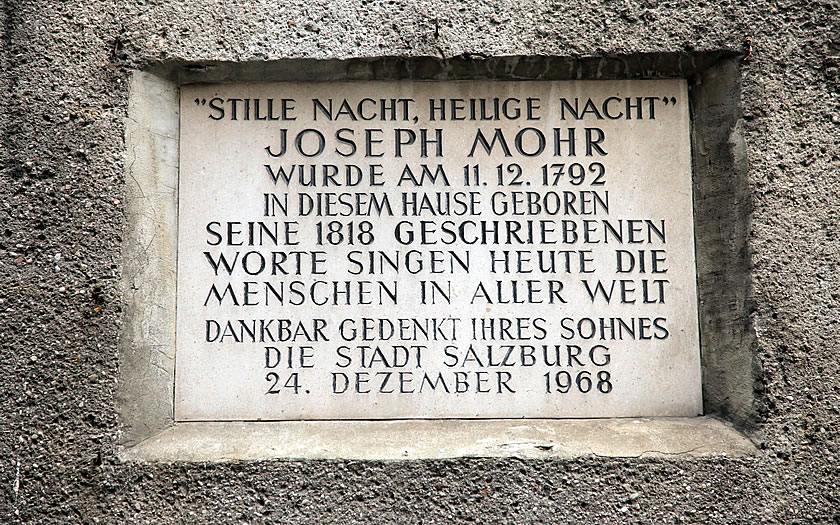
Interesting facts about ‘Silent Night’:
- The song composer Franz Xaver Gruber (1787 – 1863) lived in Hallein for 28 years. The town hosts the most extensive archive of “Silent Night”. The new Silent Night Museum Hallein will open on 29 September 2018.
- The history of the origin of the song is closely linked to the Napoleonic Wars and the decline of river traffic on the Salzach. In the Silent Night Museum in Oberndorf you can learn about the historical background. The Silent Night Memorial Chapel is a truly magical place for lovers of “Silent Night”.
- The lyrics were written by the assistant priest Joseph Mohr. He was born in Steingasse in Salzburg and was baptized in the cathedral. Joseph Mohr’s ancestors on his father’s side came from Lungau in Salzburg, where the young priest wrote the poem “Silent Night”.
More information: www.salzburgerland.com

